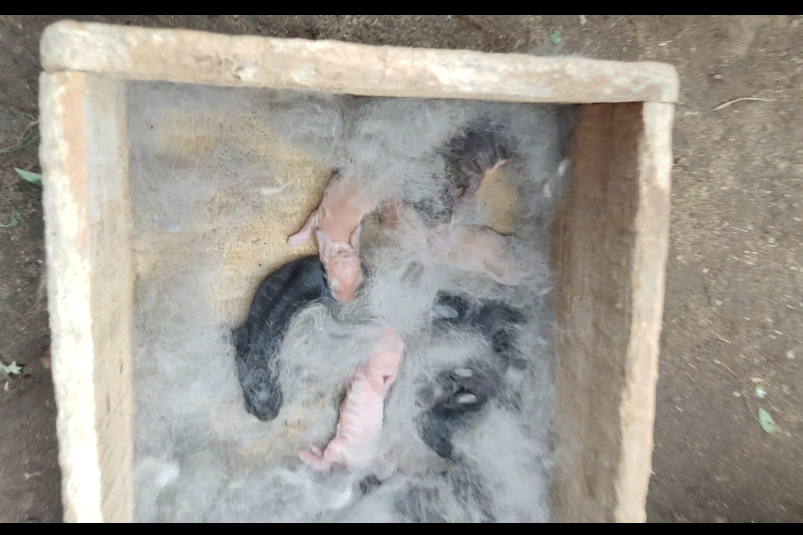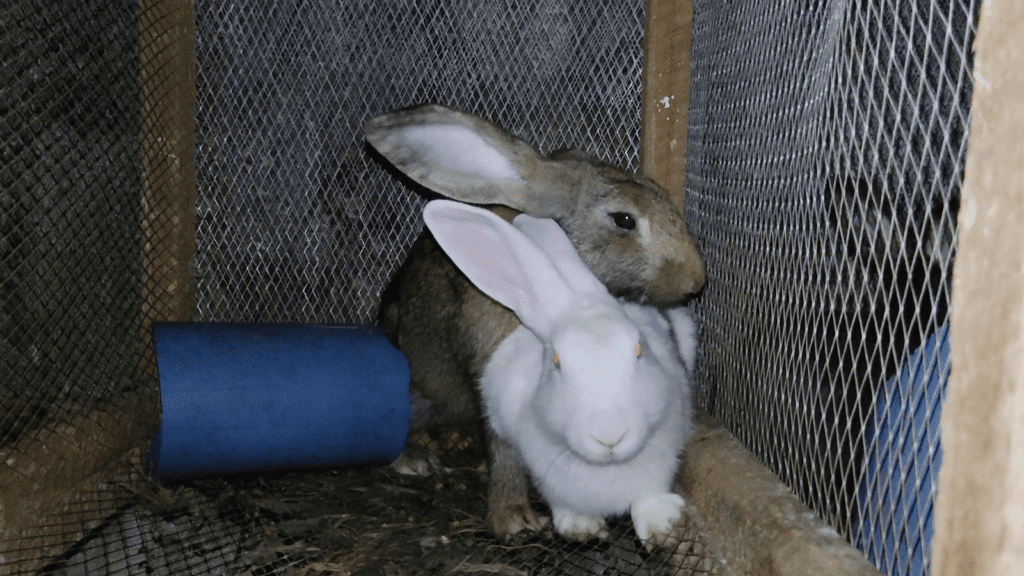Rabbits are mammals and thus have the reproduction system of most mammals. The male (Buck) has sperm and the female (Doe) has eggs. Babies are formed when a buck and a Doe mate. Rabbits have induced ovulation which means that their egg is released after it has been inseminated by a Buck. That is why a Doe can get pregnant at any time, even immediately after giving birth.
A Buck is sexually mature and ready for mating at 6 months old and can continue mating till he is up to 7 years old. One buck can impregnate several females within a short time.
A Doe is sexually mature and ready to reproduce at 4 – 6 months old depending on the breed, weight, and size. A healthy Doe can continue to have babies (kits or kittens) till she is up to 4 years old. I would advise against introducing an underweight or undersized Doe for mating even if she is up to six months old, as in my experience they produce fewer babies. The Doe, like other mammals, carries her young to term in her belly with a gestation period of 30 days. A Rabbits litter ranges between 4 to 12, However, I have seen rabbits birth just 1 and 2 kits.
How to Impregnate a Doe
To impregnate your Doe, introduce a sexually matured Buck to her enclosure. It is best to leave them together for a day, to improve their chances of mating. A Buck impregnates a Doe by mounting her from behind and inseminating his sperm. The mating encounter usually lasts less than one minute but may occur multiple times within the period they are both left in the same enclosure.

Signs of Pregnancy in Rabbits
Some rabbits may become moody and slightly aggressive as the pregnancy progresses. They will howl at you and may even scratch you if you go close to them. In some rabbits, the lower part of their neck becomes distended.
A pregnant doe’s belly gets bigger as her babies keep growing in her womb. Therefore, a growing belly is a sign of a rabbit being pregnant. However due to their furs, a growing belly might not be obvious, so it is better to rely on other signs or methods.
Also, two weeks after mating, you should feel the babies inside your Does tummy when you press it. They will feel like small stone-sized bumps but they’ll be big enough for you to feel.
My recommendation is that, if your sexually matured doe has had any contact with a sexually matured Buck then it is very likely that she is pregnant and you best start counting the days. This is because their induced ovulation makes the likelihood of pregnancy very high. Also, in my experience, you may not notice any physical changes indicative of a pregnancy.
Signs of pending Delivery
Most rabbits show signs of pending delivery by carrying out certain preparations, within a week of its occurrence. She may begin to nest by carrying things from her enclosure such as hay to a corner to make a nest. She may pull her fur to line the nest when the delivery is between 1 to 2 days. The fur will help to keep the furless kits warm and also expose the Does breasts for easy sucking. The rabbit also begins to produce milk within a week of delivery. To check if her breast has started secreting milk, just gently squeeze her breast and if milk secretion has begun, it will ooze out.
However, in my experience, some rabbits don’t show any signs or make any preparations, so again it is best to count the days from when the Doe was introduced for mating. I have experienced rabbits nesting and pulling their fur, only after birthing their litter.
Preparing for your rabbits delivery
In the wild, rabbits nest in dug-up burrows and instinctually visit the litter at the right time to breastfeed. These burrows provide protection for fragile kittens.
Therefore, it is best to provide something that can mimic the borrow for your domesticated doe to birth in. Something that will provide an enclosure that prevents the mother’s fur from scattering, the kits from roaming, and the kits from getting trampled by their mother. It will also protect the kit’s fragile feet from the rabbit cage.
I made a box using wood which I place in the rabbit cage within a week of the due date. Some Doe’s will instinctually know that I am providing a sort of borrow for their litter and will pluck their furs into the box. However, some Doe will still pluck their furs onto the cage floor. If that happens, I pick the furs and place them in the birthing box.
Also please ensure that the mesh net is relatively small in the birthing cages so it does damage the small feet of the kits.

Rabbit Delivery
Rabbits give birth at night or in the early morning. The birthing process takes less than 15 minutes, depending on the size of the litter. The process does not require human assistance as the Doe knows what to do instinctually.
In ideal situations, if you have placed a birthing box in the cage, the rabbit will birth inside the box. However, sometimes they still give birth on the cage floor. So do well to check the cage, very early every morning as the birthday approaches, so if birthing is done on the cage floor, you can intervene to prevent trampling to death by the mother. I have lost many kits due to mothers trampling. If she dropped furs in the cage too, you pick them up and place them in the box for her.
Rabbit Babies
The kits are born furless, deaf, and blind. However, they can locate and suck the mother’s breast. The doe has multiple Breasts on her belly and side which is enough to feed multiple kits at the same time. Rabbit breast milk is very nutritious and each breastfeeding episode takes less than 5 minutes.
The kits become fully developed within 2 weeks, they start growing fur and their eyes and ears begin to open. At about 3 weeks, they are ready to leave the birthing booth and stay in the cage. The kits begin eating food and are ready to be fully weaned at 5-6 weeks old. At this stage, you may separate them from the mother. With a gestation period of 1 month and a weaning period of 1 month and 2 weeks, a doe can give birth more than 3 times in a year.
Please ensure your cage is rodent and snake-proof (use small mesh nets) because I have lost a couple of kits to rats before. Also, ensure your mother is well fed and water is available, remember she is making food for the kits. Rabbit babies are very delicate and must be carefully protected. Their mortality rate can be very high, so one must take extra precautions to prevent it.


